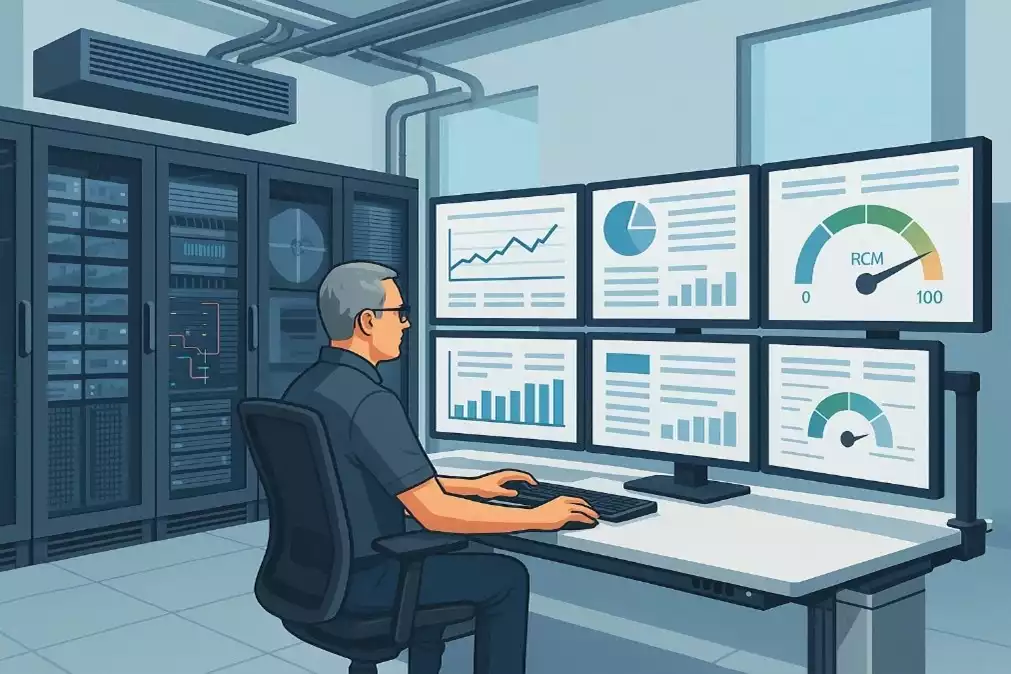
With the increasing complexity of process automation, digital control technology and 24/7 availability, the demands on control rooms as the centrepiece of many safety-critical systems are growing. Just as with data centres, protection against power failures, faults and technical malfunctions is essential. Continuous residual current monitoring (RCM) makes a decisive contribution here.
Control rooms are central switching points for industrial processes, energy supply, traffic control centres or safety-relevant infrastructures. They must function fault-free at all times. Continuous residual current measurement is a key instrument here:
Early detection of insulation faults and leakage currents: RCM systems detect residual currents at an early stage before they can lead to equipment faults, corrosion or even fires.
Prevention of operational failures: Instead of sudden disconnection by classic RCDs, RCM allows targeted and plannable maintenance.
Legal compliance: Regulations such as DIN VDE 0105-100/A1 or DIN EN 50600-2-2 increasingly require continuous monitoring, even in environments such as control centres or control rooms.
Sustainability and efficiency: Continuous monitoring reduces testing costs and fulfils operational safety requirements.
RCM technology compares incoming and returning current. Differences indicate fault currents - e.g. due to damaged cables, insulation damage or faulty consumers. These can be analysed in the control room using
Modular measuring systems,
Connection to higher-level control technology (e.g. SCADA, BMS),
centralised alarming and documentation
efficiently and in a centralised manner. This is a strategic advantage, especially for systems with high availability requirements (e.g. control centers, energy distribution, traffic control centers).
In addition to the technical necessity, RCM also offers economic and organisational benefits:
Minimisation of unplanned downtimes
Fewer maintenance cycles thanks to targeted maintenance
Transparency regarding power quality problems
Reduction of insurance costs and liability risks
Today's control rooms are no longer static operating rooms - they are highly networked, safety-critical control centres. Continuous residual current monitoring is therefore a standard feature of any future-proof infrastructure planning. RCM should be considered as early as the design phase - not only to comply with legal requirements, but also as an instrument for safeguarding technical operations management.
Those who continuously monitor their control room technology react faster, avoid failures and increase operational safety in the long term.
Are you planning a new control centre or would you like to optimise your infrastructure?

Send us a non-binding inquiry
We’re here for you!
Whether you need individual solutions, technical advice or a personal consultation – we’re happy to help. Just fill out the contact form and our team will get in touch with you as soon as possible.
We look forward to your message!
Knürr GmbH Headquarters
Mariakirchener Straße 38, 94424 Arnstorf
Mayteck Ltd.
Unit 6, Headley Park Nine, Headley Road East, Woodley, Berkshire, RG5 5SQ
Simon Wicks
Carolyn Hill
Alan Gray
Alexander SCHNEIDER Ltd.
54 Hazoran St., P.O. Box 8449, IL - Netanya 42504
Moshe Sasson
Mano Weismann
Piomar
ul. Swiderska 35, 03-128 Warszawa
Jerzy Sulkowski
Magic View s.r.l.
Str. Sofia nr. 4, sector 1, cod 011838, Bucuresti
Teodor Munteanu
George Stroe
S.I.G., S.A.
Calle Suecia 8, Polig. Ind. Jumapi, E - 28812 Alcala de Henares (Madrid)
David Segura
Dafnia Electronics L.L.C.
P.O.Box 32788, Dubai - United Arab Emirates
Oliver Dsouza
ControlConsoles
213 Ellyridge Court, San Jose, CA 95123
Randy Duke
Steve Wells
Industrimøbler AS
Bjørnerudveien 12 A, N-1266 Oslo
Erik Lindseth
Stian A. Tvindesaeter